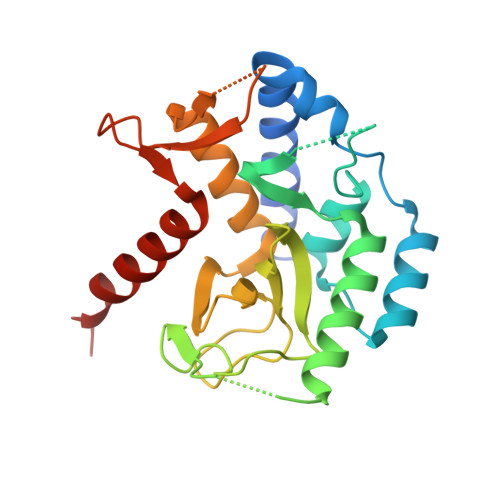The Conserved Yeast Protein Knr4 Involved in Cell Wall Integrity Is a Multi-domain Intrinsically Disordered Protein.
Batista, M., Donker, E.I.M., Bon, C., Guillien, M., Caisso, A., Mourey, L., Francois, J.M., Maveyraud, L., Zerbib, D.(2023) J Mol Biol 435: 168048-168048
- PubMed: 36933821
- DOI: https://doi.org/10.1016/j.jmb.2023.168048
- Primary Citation of Related Structures:
8AJ2 - PubMed Abstract:
Knr4/Smi1 proteins are specific to the fungal kingdom and their deletion in the model yeast Saccharomyces cerevisiae and the human pathogen Candida albicans results in hypersensitivity to specific antifungal agents and a wide range of parietal stresses. In S. cerevisiae, Knr4 is located at the crossroads of several signalling pathways, including the conserved cell wall integrity and calcineurin pathways. Knr4 interacts genetically and physically with several protein members of those pathways. Its sequence suggests that it contains large intrinsically disordered regions. Here, a combination of small-angle X-ray scattering (SAXS) and crystallographic analysis led to a comprehensive structural view of Knr4. This experimental work unambiguously showed that Knr4 comprises two large intrinsically disordered regions flanking a central globular domain whose structure has been established. The structured domain is itself interrupted by a disordered loop. Using the CRISPR/Cas9 genome editing technique, strains expressing KNR4 genes deleted from different domains were constructed. The N-terminal domain and the loop are essential for optimal resistance to cell wall-binding stressors. The C-terminal disordered domain, on the other hand, acts as a negative regulator of this function of Knr4. The identification of molecular recognition features, the possible presence of secondary structure in these disordered domains and the functional importance of the disordered domains revealed here designate these domains as putative interacting spots with partners in either pathway. Targeting these interacting regions is a promising route to the discovery of inhibitory molecules that could increase the susceptibility of pathogens to the antifungals currently in clinical use.
Organizational Affiliation:
Toulouse Biotechnology Institute (TBI), Université de Toulouse, CNRS, INRAE, INSA, F-31077 Toulouse, France; Institut de Pharmacologie et de Biologie Structurale (IPBS), Université de Toulouse, CNRS, UPS, F-31062 Toulouse, France.














